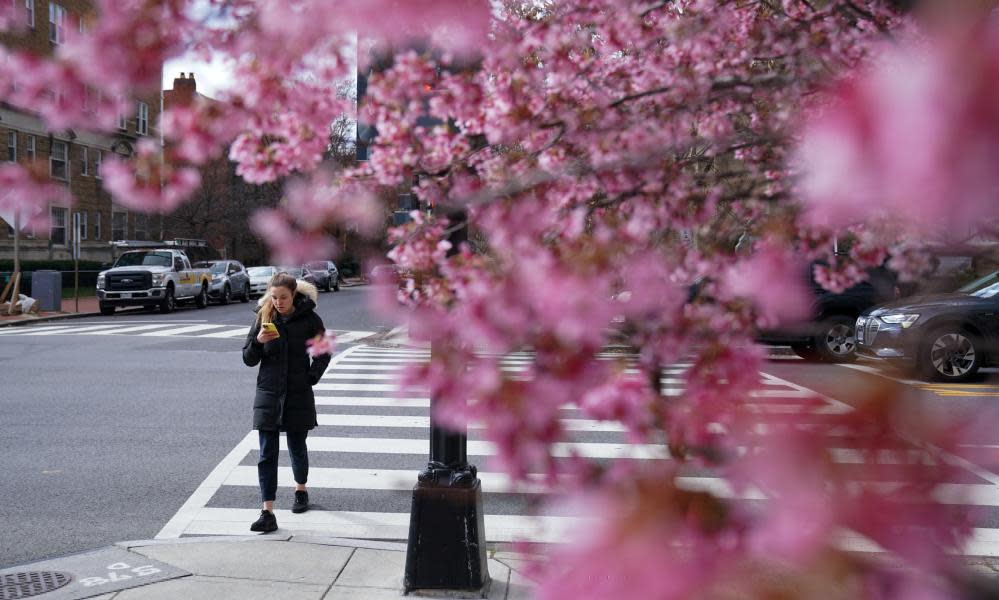Parts of US see earliest spring conditions on record: ‘Climate change playing out in real time’

Blooming daffodils in New York City. Leaves sprouting from red maples in North Carolina. Cherry blossoms about to bud in Washington. Record winter warmth across much of the eastern US has caused spring-like conditions to arrive earlier than ever previously recorded in several places, provoking delight over the mild weather and despair over the unfolding climate crisis.
In New York, one of several US cities to experience its warmest January on record, spring conditions have arrived 32 days before the long-term normal, which is its earliest onset of biological spring in 40 years of charting seasonal trends by the National Phenology Network.
Spring activity has, meanwhile, arrived at least 20 days earlier than usual for huge swathes of the US south-east and east, with parts of central Texas, south-east Arkansas, southern Ohio and Maryland, along with New York, all recording their earliest spring conditions on record so far this year.
“It’s a little unsettling, it’s certainly something that is out of the bounds of when we’d normally expect spring,” said Teresa Crimmins, director of the National Phenology Network and an environmental scientist at the University of Arizona. “It perhaps isn’t surprising, given the trajectory our planet is on, but it is surprising when you live through it.”
Winter has barely registered for millions of people in the US north-east, with states across the New England region all experiencing their warmest January in the 155-year national record. New York City, which experienced more lightning strikes than snowfall in a balmy month, notched an average temperature 10F higher than the long-term average. The Great Lakes, meanwhile, have had a record-low amount of ice coverage during their usual February peak.
The procession of warm days has coaxed flowers from plants, with thousands of citizen observers reporting early budding in numerous locations to the National Phenology Network, a coalition of academics, government agencies and volunteers. Volunteers on the ground have noted instances of blooming over the past 15 years, while the longer 40-year record comes from a model of spring-like conditions devised by the network.
This year, blooms have already been emerging from common lilacs in Pennsylvania, eastern redbuds in Virginia, tulip trees and red maples in North Carolina, and daffodils and violets in New York City, observers have told the network. Perhaps the most famous symbol of spring in the US, the cherry blossoms found in the heart of Washington DC, have started to bud, too, and could break a three-decade record for early blossoming, according to the National Park Service.

The warm winter, and the galloping arrival of spring-like weather, is part of a longer-term trend of milder winters and scrambled seasons due to the heating of the planet caused by the burning of fossil fuels. Crimmins said her network of observers have voiced “surprise, concern and anxiety” over another early spring, which follows a string of similar early onsets over the past decade or so.
“This year the US has clearly been chopped in half and the eastern half is so much further ahead of schedule in terms of spring,” she said. “Almost everyone I speak to about this has this existential anxiety that we are seeing climate change playing out in real time.”
Related: Stronger El Niño events may speed up irreversible melting of Antarctic ice, research finds
While many people may celebrate a winter without the need for heavy coats or wariness over slippery ice and snow, the rapid arrival of spring conditions has a host of negative ramifications, scientists say. Pollen pumped out by prematurely unfurling plants can trigger earlier seasonal allergies and parasites such as ticks, some able to spread afflictions such as Lyme disease, are able to spread and establish themselves at a time when temperatures should be too cold for them to thrive.
More fundamentally, the shifting seasons risk severing a whole series of relationships essential to the natural order. Insects may miss feeding upon early-blooming plants, while migrating birds, which decide to start their seasonal journeys by the length of the day, may find a dearth of food for them when they arrive. The plants, meanwhile, risk being killed off by frosts that can arrive after they’ve blossomed.
Everything has been thrown out of whack, species that have evolved together for millennia are now off-kilter
Dr Deborah Landau, director of ecological management at the Nature Conservancy
This situation poses a threat to the food system, which is reliant upon insect pollination, and gives an edge to certain invasive species of plant that thrive in the warmer conditions, according to Dr Deborah Landau, director of ecological management at the Nature Conservancy.
“I’m seeing the trends I rely upon, the calendar I have trusted to see rare plants in bloom, just completely disappear,” said Landau, who has been charting plant and animal behavior for the past 22 years. “Everything has been thrown out of whack, species that have evolved together for millennia are now off-kilter. There is this cascading effect on everything that is more than just a missed cherry blossom season.”
Landau said that people will start to see the true costs of early springs through higher prices for certain pollinator-dependent foods and the spread of tick-borne diseases, even if the consequences of this are still not apparent to most.
“I’m seeing things green up and bud early and the weather reports just say ‘lucky you, what another lovely warm day,’” she said. “I just groan because I know the pollinators won’t have anything to eat. It’s frustrating.”

